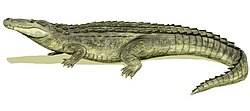Taxonomy
The type species, A. polyodon, is from the Eocene-age Bridger Formation of Wyoming; it is based on fossils that are difficult to distinguish from other Paleogene alligatorids. A. heterodon is from the Eocene-age Wasatch Formation of Wyoming, A. wartheni is from the Eocene-age Wildwood Formation (also known as the "Wildwood alligatorid" and possibly two species), and A. woutersi, which may belong to Diplocynodon , instead, is from the Early Eocene of Belgium. A. polyodon, A. heterodon, and A. wartheni span the Clarkforkian, Wasatchian, and Bridgerian North American Land Mammal Ages. [4]
Several other genera and species were previously assigned to Allognathosuchus, giving it a potential Upper Cretaceous-Oligocene stratigraphic range, and a geographic range covering North America, Europe, and Africa. Christopher Brochu reviewed the genus in 2004, and in light of the fragmentary remains of several of the species involved, recommended conservative use of the genus. He excluded Albertochampsa langstoni , Arambourgia gaudryi , and Wannaganosuchus brachymanus from Allognathosuchus, and resurrected Hassiacosuchus and Navajosuchus from synonymy with Allognathosuchus after finding them not to group with A. polyodon to the exclusion of other alligatorines. [4]
Recent studies have consistently resolved Allognathosuchus polyodon and Allognathosuchus wartheni as members of Alligatorinae, although their relative placement is disputed, as shown by the cladograms below. [5] [6] [7]
Cladogram from 2018 Bona et al. study: [5]
Cladogram from 2019 Massonne et al. study: [6]
Cladogram from 2020 Cossette & Brochu study: [7]
This page is based on this
Wikipedia article Text is available under the
CC BY-SA 4.0 license; additional terms may apply.
Images, videos and audio are available under their respective licenses.



